How to Choose the Right Car Battery for Extreme Weather Conditions?
Today we discuss Choose the Right Car Battery for Extreme Weather Conditions. Extreme weather conditions can be a real challenge for car batteries. When temperatures reach scorching highs or plummet to freezing lows, a weak battery can leave you stranded. So, how can you choose the right car battery for such harsh conditions?
The answer lies in understanding the specific requirements and features that can make a battery perform optimally in extreme weather. In this article, we will explore the important factors to consider when selecting a car battery that can withstand the tests of temperature extremes. From battery capacity to cold cranking amps, we’ve got you covered with expert tips to ensure your vehicle stays powered up, regardless of what Mother Nature throws its way.
How to Choose the Right Car Battery for Extreme Weather Conditions?
Extreme weather conditions can be tough on vehicles, especially their batteries. When temperatures drop below freezing or soar to scorching levels, car batteries can face significant challenges. Choosing the right battery for such conditions becomes crucial to ensure your vehicle starts reliably and performs optimally. In this article, we will explore key factors to consider when selecting a car battery for extreme weather conditions.
1. Understanding Battery Types
Before delving into the specifics of extreme weather considerations, let’s first understand the different types of car batteries available in the market:
- Lead-Acid Batteries: These are the most common type of car batteries and are known for their affordable price and reliable performance.
- AGM (Absorbent Glass Mat) Batteries: AGM batteries are maintenance-free, provide high power output, and have excellent resistance to vibration, making them suitable for extreme conditions.
- Gel Batteries: Gel batteries use a thickening agent to immobilize the electrolyte, making them spill-proof and vibration-resistant. They are ideal for deep cycling applications.
- Lithium-Ion Batteries: Lithium-ion batteries offer a lightweight and compact alternative with a longer lifespan and faster recharging capabilities. However, they tend to be more expensive.
Each battery type has its advantages and disadvantages. However, when it comes to extreme weather conditions, AGM and gel batteries are often the preferred choices due to their ability to withstand harsh environments.
2. CCA Rating: Cold Cranking Amps
One of the most critical factors to consider when choosing a car battery for extreme weather conditions is its Cold Cranking Amps (CCA) rating. CCA measures a battery’s ability to start your vehicle in cold temperatures. The higher the CCA rating, the better the battery’s performance in freezing conditions. For extremely cold climates, aim for a battery with a CCA rating that exceeds your vehicle manufacturer’s recommendations.
3. Reserve Capacity
Reserve Capacity (RC) refers to the duration a fully charged battery can power your vehicle’s essential functions, like lights and ignition, in case the alternator stops functioning. In extreme weather conditions, having a battery with a higher reserve capacity can provide you with peace of mind, especially during prolonged periods of low temperatures or high heat.
4. Maintenance and Durability
Extreme weather conditions can accelerate the wear and tear on car batteries. It’s essential to choose a battery that requires minimal maintenance and offers exceptional durability. AGM and gel batteries, with their sealed design, are generally more resistant to damage caused by temperature fluctuations and vibrations.
5. Brand Reputation and Warranty
When it comes to choosing a car battery, reputable brands with a proven track record are worth considering. Established brands often invest in research and development to create batteries specifically designed for extreme weather conditions. Additionally, check the warranty offered by the battery manufacturer, as it can serve as an indicator of their confidence in the product’s performance and durability.
6. Size and Compatibility
Ensuring the battery you choose is the correct size and compatible with your vehicle is crucial. Check your vehicle’s manual or consult with a professional to determine the appropriate battery size, terminal placement, and compatibility requirements. Installing an ill-fitting or incompatible battery can result in poor performance and potential damage to your vehicle’s electrical system.
7. Venting Mechanism
In extreme weather conditions, batteries can generate excess heat or gas buildup. To prevent potential hazards, consider batteries equipped with a venting mechanism. This feature helps dissipate heat and release any gases that may accumulate during operation.
8. Price and Value
While price is an essential consideration, it should not be the sole determining factor when selecting a car battery. Instead, focus on the overall value offered by the battery in terms of its performance, durability, and suitability for extreme weather conditions. Investing in a high-quality battery designed to withstand harsh environments can save you money in the long run by minimizing the risk of battery failure and costly repairs.
9. Environmental Considerations
Sustainable and eco-friendly options are gaining popularity in the automotive industry. If you prioritize environmental consciousness, you may want to explore car battery options that are recyclable, contain fewer hazardous materials, or have a minimal carbon footprint throughout their lifespan.
10. Consult with Experts
When in doubt or facing specific challenges related to extreme weather conditions, it is always wise to consult with automotive experts, such as mechanics or car battery specialists. These professionals can provide valuable insights and recommend the most suitable battery for your vehicle and climate conditions.
In conclusion, choosing the right car battery for extreme weather conditions involves considering factors such as the battery type, CCA rating, reserve capacity, maintenance requirements, brand reputation, size compatibility, venting mechanism, price, and environmental considerations. By taking these factors into account and consulting with experts, you can ensure your vehicle is equipped with a reliable and robust battery that performs optimally even in the harshest weather conditions. Stay prepared and enjoy worry-free driving regardless of the temperature outside.
How To Choose A Car Battery (Simplified)
Frequently Asked Questions
How do extreme weather conditions affect car batteries?
Extreme weather conditions, such as extreme heat or cold, can significantly impact the performance and lifespan of car batteries. High temperatures can cause the battery fluid to evaporate, leading to internal damage, while extremely low temperatures can reduce the battery’s ability to provide sufficient power. It is essential to choose a car battery that can withstand the specific climate conditions you frequently encounter.
What factors should I consider when selecting a car battery for extreme weather conditions?
Several factors should be considered when choosing a car battery for extreme weather conditions. These include the battery’s capacity, reserve capacity, Cold Cranking Amps (CCA) rating, and Battery Council International (BCI) group size. Opting for a battery with a higher CCA rating and reserve capacity will ensure reliable starting power even in harsh weather conditions. Similarly, selecting a battery that fits your vehicle’s specified BCI group size is crucial for a proper fit.
Is a higher CCA rating always better for extreme weather conditions?
In extreme weather conditions, a higher Cold Cranking Amps (CCA) rating is generally preferable. This rating indicates a battery’s ability to deliver a strong burst of power during cold starts. However, it’s essential to consider the manufacturer’s recommendations and your vehicle’s requirements. Choosing a battery with too high a CCA rating may lead to unnecessary expenses and could potentially overload your vehicle’s electrical system.
Which battery type is better for extreme weather conditions: flooded or AGM?
Both flooded and Absorbed Glass Mat (AGM) batteries have their advantages in extreme weather conditions. Flooded batteries are generally more affordable, but they require regular maintenance to check fluid levels. AGM batteries, on the other hand, are maintenance-free, have higher CCA ratings, and are more resistant to vibration and shock. If you can afford it, an AGM battery is often a better choice for extreme weather conditions due to its reliability and durability.
Should I consider a battery with a higher reserve capacity for extreme weather conditions?
Yes, it is advisable to consider a battery with a higher reserve capacity for extreme weather conditions. The reserve capacity refers to the length of time a battery can continuously supply power in case the alternator fails. Extreme weather conditions, such as prolonged low temperatures, can reduce the charging efficiency of the battery. A higher reserve capacity ensures that your vehicle will have sufficient power to run essential systems for a longer duration, providing added peace of mind.
Can I use a maintenance-free battery for extreme weather conditions?
Yes, you can use a maintenance-free battery for extreme weather conditions. Maintenance-free batteries, such as AGM batteries, are designed to withstand various weather conditions without the need for regular maintenance. They are sealed to prevent fluid evaporation and require no addition of water or electrolytes. However, it is still crucial to choose a maintenance-free battery with a suitable CCA rating and reserve capacity to meet your vehicle’s requirements in extreme weather conditions.
Final Thoughts
Choosing the right car battery for extreme weather conditions is crucial to ensure optimal performance and reliability. It is important to consider factors such as cold cranking amps (CCA) for cold climates and reserve capacity for hot climates. Additionally, selecting a battery with a durable construction and advanced technology can improve its ability to withstand extreme temperatures. Regular maintenance and monitoring of the battery’s condition are also key to prolonging its lifespan. By following these guidelines, drivers can make an informed decision when selecting a car battery that will withstand extreme weather conditions and provide reliable starting power.



